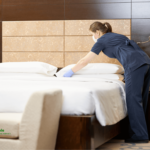Have you noticed dark spots or strange musty smells coming from your air vents? If so, you likely have a mold problem that needs addressing. Mold growth in air vents can cause a number of issues, from unpleasant odours to potential health risks if inhaled. The good news is that removing mold from air vents is quite straightforward with the right approach. In this comprehensive guide, we’ll walk you through the steps for properly eliminating mold from your vents and preventing future outbreaks.
The most important first step is to understand what’s causing the mold growth in the first place. Mold spores are present in all indoor and outdoor air. When excessive moisture gets into your air vents, it enables these spores to germinate and spread. Common culprits include:
- Leaky ductwork allows water intrusion
- High indoor humidity from lack of ventilation
- Condensation buildup inside the vents
Once you address the moisture source, you can move on to killing and removing the mold itself. When doing so, make sure to take proper safety precautions like wearing gloves, goggles, and a protective mask. Mold spores are easily inhaled, so you want to limit your exposure when cleaning.
Table of Contents
Cleaning Moldy Air Vents
Start by turning off your HVAC system and making sure the vents you want to clean are easily accessible. If you have removable ventilation grates over the vents, take those off first to improve access. Then follow these steps:
1. Vacuum the Vents
Use a vacuum cleaner attachment to remove any loose mold and debris from inside the air vents. Make sure to use a vacuum with a HEPA filter to effectively contain the mold spores.
2. Scrub With Detergent
Mix up an all-purpose detergent like Mr Muscle with warm water in a bucket. Use a stiff brush attachment on a long handle to scrub inside the air vents, coating the moldy surfaces with the detergent solution. Let it sit for 10-15 minutes.
3. Rinse Thoroughly
Use a handheld spray nozzle and clean water to rinse away the cleaning solution, mold, and debris. Flush the inside of the vents thoroughly. You may need to rinse several times to remove all the mold.
4. Disinfect with Bleach
To kill any remaining mold spores, spray the inside of the vents with an anti-mold disinfectant. A 10% bleach solution or Concrobium Mold Control work well for this. Let the disinfectant sit for 15 minutes before one final rinse.
5. Dry Completely
It’s crucial to dry the air vents fully before reassembling. Use a hair dryer or air mover to accelerate drying. Reinstall vent covers only once everything is completely dry. Running damp vents can lead to new mold growth.
For wall and floor vents, the process is largely the same. Scrub and disinfect the vent interior, then use a wet/dry vacuum to remove all standing water. Let fans run to facilitate drying before closing everything back up.
Preventing Future Mold Growth
Cleaning mold from air vents provides a temporary fix, but until you remedy the underlying moisture issue, it’s likely to keep coming back. Here are some tips for keeping your vents mold-free long-term:
- Inspect ductwork for leaks and repair any breaches with metal tape.
- Make sure bathroom exhaust fans are properly vented outdoors and run during/after showers.
- Use a dehumidifier to maintain indoor relative humidity under 50%.
- Change HVAC air filters monthly to improve airflow and reduce dust buildup.
- Have an HVAC professional clean the system’s evaporator coils, drain pans, and plenum annually.
- Consider installing ultraviolet lights in the HVAC system to inhibit microbial growth on surfaces.
With diligent moisture control and periodic cleaning, you can keep your air vents free of mold for healthier indoor air. If the mold persists despite your best efforts, contact a professional duct cleaning service for a thorough treatment.
Rest assured, with the proper approach mold in air vents can be tackled successfully. The team at Affordable Cleaning Services have extensive experience removing all types of mold throughout homes in the Parramatta region. Our trained technicians utilise industry-leading processes and EPA-approved products to eliminate mold and prevent it from coming back. For a competitive quote from our friendly, fully insured and bonded cleaners, give us a call today.
Frequently Asked Questions About Removing Mold from Air Vents:
✓What are the health risks associated with mold in air vents?
Exposure to mold spores can trigger allergic reactions, asthma attacks, and other respiratory problems in sensitive individuals. Mold also gives off musty odors and VOCs that can cause headaches, nausea, and eye/throat irritation.
✓How can I tell if there is mold inside my air vents?
Signs of mold in vents include dark specks or fuzzy growth visible through vents, increased dust around vents, stuffy stale air, and a persistent musty odor in the home. Having excess moisture in the ducts also increases risk of mold.
✓Should I seal ducts after cleaning them?
Sealing ducts is not necessary after cleaning mold, provided you fully dry the duct interiors first. Proper sealing should be done by an HVAC professional as part of an energy audit.Improper sealing can restrict airflow.
✓Can duct cleaning damage my HVAC system?
If done improperly by an untrained person, the high-powered vacuums and brushes used for duct cleaning can actually damage your HVAC system. Always hire certified pro duct cleaners.
✓How often should air vents be cleaned?
For mold prevention, vents should be cleaned annually along with a full HVAC system inspection. If you have allergies or pets, cleaning vents every 6 months may be best to remove dust and dander.






